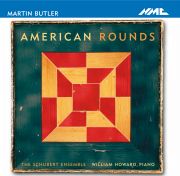|
Rivers appear so often in the music of Martin Butler that one could be forgiven for thinking he was creating not so much an oeuvre as a landscape, a terrain sculpted by the movements of water across and through it. Alternatively, one might observe the various forms that water itself takes in individual works: its flow from land out to sea or its rest in pools; its fall as rain; its solid state as ice waiting to thaw. Touching as they do on continuity and interrelatedness as well as on difference and specificity, such metaphors seem appropriate to the discussion of a composer whose work continually revisits and transforms its own preferred materials and processes – materials derived from folk music, from the sound of bells ringing, or from the potential of both to generate rhythmic regularity or irregularity; processes derived from the relative abstraction of constant rhythmic motion, whether in streams (another liquid metaphor!) of evenly flowing quavers, fast motor rhythms, or the slower, less earthly motion of prayer and chorale.
In the first piece on this disc the terrain is America, or more specifically its folk regions, and the piece falls into a category of works by Butler (earlier examples include Hootenanny, Down-Hollow Winds and Bluegrass Variations) that draw on aspects of that country’s folk music. No actual melodies are quoted, but each movement focuses on, in the composer’s words, ‘a tiny amount of highly characterised musical material derived from the scales, gestures and performing practices of different American folk idioms’. They are ‘little folk games’, as Butler has it in the title of the short piano pieces which are remade as the first two movements here – another instance of difference amid repetition.
[…]
Butler’s teacher Berio is remembered in the piano quartet Sequenza Notturna, written in the month after his death in 2003. The piece revives several preoccupations which were prominent in Butler’s earlier work: notably the idea of a thread of melody, sometimes audible, sometimes hidden but controlling aspects of the harmony or structure. In Sequenza Notturna the thread is initiated by a repeated-note figure in the viola, serving a similar function to the dotted-note melody in Funérailles, though here it enters earlier into proceedings and quickly ramifies to impel the piece onward through a sequence of episodes including a ‘ghostly sarabande’ unfolding in gentle heterophony, a quicker, energetic folk-like dance, and an impassioned recitative for all three string instruments in unison which, the composer has suggested, locates this evocatively nocturnal piece somewhere in Moorish Spain.
The principle of a guiding thread of melody spanning the piece relates closely to Berio’s own working methods, and instances in the older composer’s oeuvre also give a precedent for its metaphorical association with the image of a river. Thus the river becomes in Butler’s work a metaphor for Berio, too, and a poetically apt one at the quiet end of the piece, to which Butler appends the phrase (from Larkin’s The Whitsun Weddings) ‘… somewhere becoming rain’ – rain, of course, being what happens to rivers when they leave the earth.
© 2007 John Fallas
[from the booklet notes to Martin Butler: American Rounds (The Schubert Ensemble; NMC D120)]
for more information, to reproduce any material from this website, or to commission new articles or programme notes, please contact jfallas @ worldisnow . co . uk (no spaces) |
|
  |